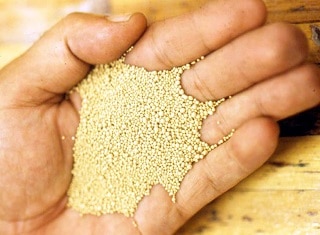
Dried pure culture yeast.
The reasons for sluggish or stuck fermentations have historically been attributed to viticultural or cellar aspects. Viticultural aspects include crop size, sugar concentration of the grapes, yeast nutrient concentration and spray residues, while the choice of yeast strain, yeast rehydration process, fermentation temperature, juice clarity, nitrogen concentration of the juice, inhibiting compounds and physical factors are determined by cellar management. More recent research however, emphasise the importance of the glucose-fructose ratio of the juice.
According to the historical follow-up of sluggish or stuck fermentations, the determining factor in 90 or even higher percentage of the cases where it occurred was the glucose-fructose ratio in the juice being less than 1. The fructose concentration was consequently higher than the glucose concentration of the juice. This is intelligible, because the general wine yeast, Saccharomyces cerevisiae, is a glucophilic yeast, which prefers glucose more than other sugars. Many people believed that Saccharomyces bayanus strains will solve the problem, which is actually wrong. By using DNA-technology for the taxonomic classification of yeasts, it was found that most yeast species or strains are a mixture of various strains with one or two dominant parents. This confirmed that yeast strains, which were generally known as Saccharomyces bayanus strains in the wine industry, were actually wrongly identified. It was actually Saccharomyces cerevisiae strains of the “Pris de Mousse” family. This conclusion was supported by the apparent discovery of a Saccharomyces bayanus strain in a pathogenic isolation. Further research did however find that it was actually Saccharomyces eubayanus. Only a few of these strains, which are cold tolerant and non-fructophilic, were isolated and even less are commercially available.
During alcoholic fermentation the breakdown rate of glucose is mostly faster, which leads to an increase of the fructose-glucose ratio. When this happens, it can lead to sluggish or stuck fermentations. Saccharomyces cerevisiae strains are mostly used in wine cellars, but strains differ regarding their fructophilic or glucophilic ability.
As a result of the emphasis on especially fruit-driven wines with softer tannins, the alcohol concentration of wines increased over recent years. Alcohol concentrations of 14 – 14.5% per volume are common and concentrations of 15% also occur. More emphasis was consequently placed on the connection between the physiological ripeness and sugar concentration of grapes. In regions with a warmer climate, physiological ripeness usually implicates higher sugar concentrations. The influence of physiological ripeness is however more influential on wine quality, which can consequently lead to the higher sugar concentration of grapes.
The development of grape berries consists of three growth phases. During phase one the berries are formed, its respiration rate is fast and the berries are green. Photosynthesis is consequently sufficient to fulfil the nutrient requirements of the berries. The acid concentration of the berries is high and the sugar concentration low and remains constant. During this phase the glucose-fructose fermentation ratio is more than one. During phase two the growth of the berries decreases, the acid concentration maximises and glucose commences to accumulate. This phase is terminated when the berry colouring commences. Phase three is characterised by a mass and size increase of the berries and the glucose-fructose ratio is balanced. During further ripening or raisin formation the fructose concentration increases. The time that grapes remain on the vine from this point has far-reaching results. It is not only the wine quality which is influenced, but it can also lead to sluggish or stuck fermentations. Residual fructose results in a lower alcohol concentration and can also lead to microbiological problems. These problems can be prevented to a certain extent by using fructophilic yeasts, which have a preference for the degrading of fructose.
It has already been known since 1932 that the sugar preference of yeast strains differs. The preference is however not constant and is influenced by the culture circumstances during yeast growth. Further research however indicated that residual fructose is not necessarily the reason for fermentation problems, but must rather be seen as a symptom of it.
The performance of yeasts is partially determined by its genetic composition, which is dependent on the species and strain. Wine yeast strains vary regarding their fermentation kinetics, nitrogen requirements, ethanol resistance, temperature tolerance and glucose or fructose degrading. These differences are more obvious under stress conditions, which are influenced by the adaptability of strains thereto. The degrading of fructose is enhanced by nitrogen additions during fermentation, while higher alcohol concentrations inhibit fructose degrading more than glucose degrading. Although the use of fructophilic yeast strains cannot prevent fermentation problems, it can definitely contribute to limit its possibility.
If fermentation problems can be attributed to the glucose-fructose ratio of grape juice, it must be differentiated amongst different cultivars. Chardonnay for example, is more likely to cause problems than Chenin blanc. Different vintages can also play a role, because drier years usually result in a lower ratio. The choice of yeast strain is consequently influenced by the ratio. If the fructose concentration is more than the glucose concentration, more attention must also be given to stress factors like the yeast assimilable nitrogen (YAN) and the expected final alcohol concentration. Fermentation problems are usually not caused by a single factor, but rather a combination of factors. If the nitrogen concentration of grape juice is for example replenished, 6 – 9% more glucose and 13 – 17% more fructose are degraded by yeasts. A di-ammonium phosphate addition at the end of alcoholic fermentation will also favour the degrading of fructose (Mabbett, 2019).
Reference
Mabbett, J., 2019. Fructophilic yeasts. Consequences of yeast strain selections. Wine Business Monthly, June 2019: 44 – 48.













